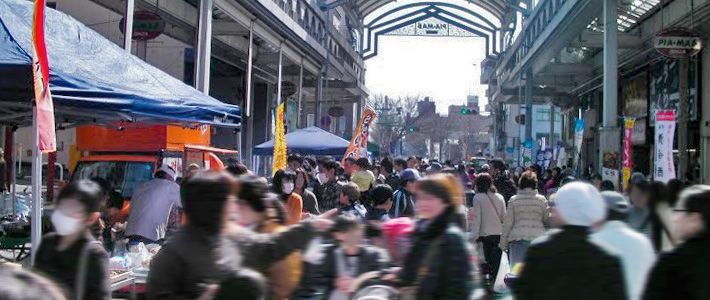
Aging in Japan and Across Asia
As Regions Age, Shopping Centers Strive to Adapt
Society- English
- 日本語
- 简体字
- 繁體字
- Français
- Español
- العربية
- Русский
The Truth About Shopping Districts in Decline
There are currently about 1,800 municipalities in Japan. As the country’s population ages and rural residents head for the cities, though, fully half of these are projected to see their populations dwindle to zero by 2040. The city of Shūnan, Yamaguchi Prefecture (population 150,000) was once a thriving industrial city, but advances in automation reduced the number of people employed by those industries. Lower employment and an aging population is turning Shūnan’s once-vibrant commercial district into a “shuttered street,” with large numbers of businesses closed permanently, marked only by the dingy metal shutters lowered over their once welcoming storefronts.
In survey of 8,000 shopping districts across Japan conducted by the government’s Small and Medium Enterprise Agency, just 1% of respondents reported that their own shopping center was thriving. What is more, the bulk of that 1% actually represented retail outlets operating in large-scale shopping malls, rather than in the shopping arcades that have traditionally served local communities.
The decline of the shopping district has largely been blamed on the rise of the shopping mall. Large shopping malls with expansive parking lots are undeniably convenient, and this competition has surely lured some shoppers away from traditional shopping districts.
However, even if shopping malls are a factor in the decline of the shopping district, I disagree with the idea that they are the cause of that decline. Rather, the cause is storekeepers giving up on maintaining or expanding their business. A street full of stores run by shopkeepers who have lost their will to do business is unlikely to hold much appeal for potential shoppers.
A lack of successors is another major cause of the decline. Children of storekeepers tend to be employed in cities or prestigious regional companies, and not all are able to return and run the family store instead. Combined with a lack of new investment or new service offerings, the result is that stores are being left behind by the changing times.
What Visitors Want: The Whole Shopping Experience
I am president of Machi Ai Tokuyama, an organization founded in 2010 with investment from the city government of Shūnan, the local chamber of commerce, and the local shopping district. We are dedicated to revitalizing the district. In May 2016, our shopping district was selected as one of the Small and Medium Enterprise Agency’s “30 Vibrant Shopping Districts”—proof that our unique methods were able to successfully revitalize an area that had been in decline.
Initially, we focused on inviting young people to events held nearly every month, trying desperately to inspire new motivation in storekeepers. However, no matter how hard we tried, the number of shoppers visiting the center did not rise, and the storekeepers noted that our gatherings did not actually result in increased sales.
Going back to the drawing board, we surveyed visitors to find out what they wanted. They felt that the shopping district lacked many important stores and functions, as well as benches, toilets, and other amenities vital to a welcoming shopping environment.
Reviving Businesses by Rebuilding Communities
Based on these results, we developed a new policy of supporting storekeepers throughout the entire process of opening and running a store. In practice, this meant a great deal of patient and unglamorous work.
For example, to aid the family of an entrepreneur planning to leave their town of residence and open a general goods store in our shopping district, we made introductions to help the children settle in smoothly at their new school and provided assistance with administrative procedures of every kind. The result: the successful opening of a new store.
On another occasion, we tried to persuade a storekeeper’s son who had moved to Tokyo to return and take over the family business, a local institution. We were unfortunately unable to convince the son to return in this case, but the store space itself is now home to a prospering new business run by a 63-year-old originally born in the region who, after a career elsewhere, wanted to retire here.
By simply and honestly working to rebuild connections between people—in other words, forging a community—we have gradually expanded the circle of people determined to succeed in business in our shopping district. As a result, in the five years since 2011, we have supported the opening of more than 40 new stores and contributed to the survival or expansion of many existing businesses as well.
As new players with optimistic attitudes take on the challenges of business, foot traffic and shopper numbers are steadily increasing. We intend to continue doing the unglamorous but rewarding work of supporting Shūnan’s shopping district and our regional community.
(Originally written in Japanese. Banner photo: Shūnan’s shopping center, slowly but surely recovering its former vitality. Photo courtesy Kawamura Keitarō.)